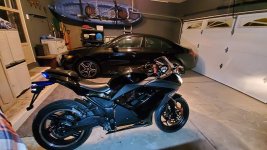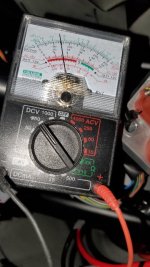Phoenix13 said:
Once I test the cells/groups, I'll put it back into the bike and use the cycle analyst from Grin Tech as the wattmeter and ride under load with the cycle analyst attached(if that's what you mean). I ordered an
XLR panel from ebikes.ca to replace the charging panel on the bike so I can use the cycle analyst for charging
The CA, to measure charging, would have to go between charger and battery. But to measure discharging, must go between battery and controller.
Since the Satiator already has a wattmeter built in, there's not a compelling reason to use the CA to measure charging, so it's simpler to put the CA's standalone shunt between controller and battery to measure just discharging.
or a wattmeter (rather than making Anderson connectors for the old charger since the cycle analyst already comes with an XLR adapter).
I haven't seen the XLR adapter for the CA (which is a wattmeter), just the Satiator (which is a charger).
I have not used the cycle analyst as a wattmeter, will it log the activity in memory or will I need to read it in real-time?
Some of the generic power meters log information, and some dont. I don't know anyd etails of any of them so can't say which would.
The CA remembers max and min for some things, so Amin is the minimum current seen, including any regen braking current that will show as negative. Amax is the maximum current seen but this includes even very very short peaks, and doesn't distinguish between that and a long high (but not as high as the peak) current draw. Watts are not logged at all, only realtime. Vmin (voltage sag) is logged, though Vmax (full charge) is not.
So to see the info needed to know what the battery has to handle, you pretty much want to be able to look at it realtime, even if it's just a glance during the highest power usage parts of teh ride, and keeping the basic number in mind.
The battery's response in votlage sag you can see with the logged Vmin, more or less, comparing that to the present-time voltage reading, after you stop, so it doens't have to be seen realtime, though it may be useful to see it during the ride at the same time as the amps.
The Satiator rememvbers the last charge cycle data, as well as lifetime data on any particular charging profile, if you use omre than one they're separate.
Not entirely sure how it will power itself during riding if I am plugging it into the charging port on th bike.
The CA would still be powered by the battery from that port, but as noted above, you would need to put it between battery and controller to measure things during a ride, vs during charging.
I think you might be confusing the Cycle Satiator (charger) and Cycle Analyst (power meter/etc).
If you get a CA vs a generic power meter with remote shunt, then for the mtorocycle you probably don't need the v3.x, the v2.x would work fine, you just have to maek sure to get the SA (standalone) model, since your controller won't have a connector built in to hook i tup to.




